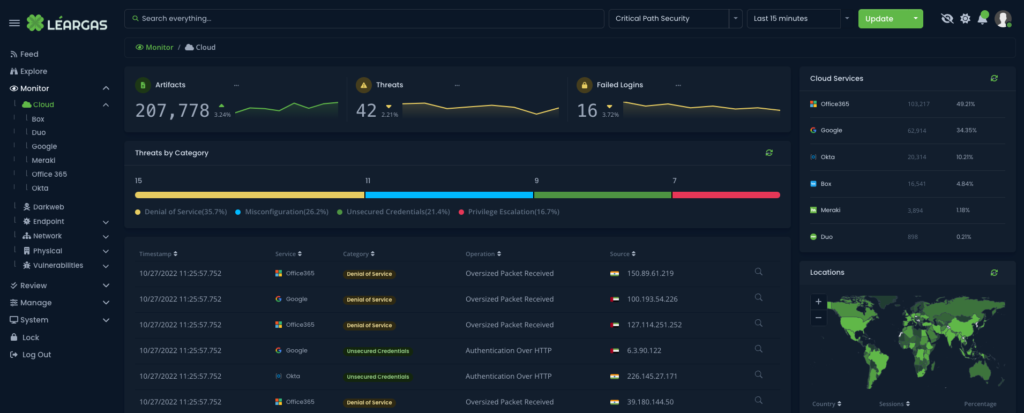
In today's digital age, cybersecurity is more critical than ever before. With the growing number of cyber threats, it is essential to reduce the attack surface to protect your organization's assets.
What is the "attack surface"?
The attack surface refers to the total number of vulnerabilities, entry points, and possible attack vectors that hackers can exploit to gain unauthorized access to an organization's systems and data. In this blog post, we will discuss the importance of reducing the cybersecurity attack surface and some effective ways to do it.
Why is reducing the cybersecurity attack surface important?
Reducing the attack surface in cybersecurity is an essential aspect of protecting computer systems and data from cyber threats. The attack surface refers to the total number of ways in which an attacker can potentially enter or exploit a system or network. This includes vulnerabilities, open ports, misconfigured settings, unpatched software, and other weaknesses that could be targeted by an attacker.
Reducing the attack surface means minimizing the number of potential entry points for an attacker to gain access to the system, which in turn reduces the likelihood and impact of a successful attack. By limiting the attack surface, cybersecurity professionals can better focus their efforts on securing the remaining entry points, which makes it more difficult for an attacker to breach the system.
Here are some specific reasons to reduce the attack surface and improve the overall security posture.
Minimize the chances of cyber-attacks: Reducing the attack surface means reducing the number of entry points that hackers can use to gain unauthorized access to your systems and data. This, in turn, minimizes the chances of cyber-attacks. By reducing the attack surface, you make it harder for hackers to exploit vulnerabilities in your systems and data, making it less likely that they will be successful.
Save time and money: Cybersecurity attacks can be costly in terms of lost revenue, damage to reputation, and the cost of repairing the damage done. Reducing the attack surface can save time and money by preventing cyber-attacks from happening in the first place. This is a proactive approach that is far less expensive than reacting to an attack after it has occurred.
Increase employee productivity: Cybersecurity attacks can cause disruptions in business operations, leading to lost productivity. By reducing the attack surface, you can minimize these disruptions, ensuring that your employees can focus on their work without being distracted by the aftermath of an attack.
Here are some specific ways to reduce the attack surface and improve the overall security posture.
Conduct a thorough risk assessment: A risk assessment will identify vulnerabilities in your systems and data, allowing you to prioritize the most critical ones and take appropriate actions to mitigate them.
Implement strong access controls: Access controls are critical in reducing the attack surface. Limit access to sensitive data to only those who need it, and use multi-factor authentication (MFA) to make it harder for hackers to gain unauthorized access.
Keep your software up-to-date: Software vulnerabilities are often exploited by hackers to gain unauthorized access to systems and data. Keeping your software up-to-date with the latest patches and updates can reduce the attack surface by closing these vulnerabilities.
Train your employees: Employees are often the weakest link in the cybersecurity chain. Regular cybersecurity training can help to reduce the attack surface by making your employees aware of the risks and how to avoid them.
So, how does Léargas help reduce and protect the attack surface?
The importance of Léargas Security in reducing the attack surface of an organization lies in its ability to provide complete visibility into all endpoints, networks, and cloud environments, and to detect and respond to threats quickly and effectively. Here are some of the ways Léargas Security can help reduce the attack surface of an organization:
Centralized visibility: Léargas Security provides a centralized view of all endpoints, networks, and cloud environments, making it easier to identify potential vulnerabilities and threats across the organization. By having a complete picture of the attack surface, security teams can identify and prioritize areas that need immediate attention and allocate resources accordingly.
Proactive threat detection: Léargas Security leverages machine learning and advanced analytics to identify threats in real-time, even in complex and dynamic environments. By detecting threats early, security teams can prevent attacks before they happen, reducing the attack surface.
Rapid response: Léargas Security allows security teams to respond to threats quickly and effectively by providing real-time response capabilities. By automating response actions and providing actionable intelligence, Léargas Security can help security teams contain and remediate threats before they can cause significant damage.
Comprehensive coverage: Léargas Security provides comprehensive coverage across all environments, including endpoints, networks, and cloud environments. By integrating multiple security technologies, Léargas Security provides a more comprehensive and effective approach to threat detection and response, reducing the attack surface.
In conclusion, reducing the cybersecurity attack surface is essential in today's digital age. By minimizing the number of entry points that hackers can exploit, you can reduce the chances of cyber-attacks, save time and money, and increase employee productivity.
Implementing the steps outlined in this post will help you to reduce the attack surface and improve your organization's cybersecurity posture.
Not sure where to start? Reach out! We're here to help!
